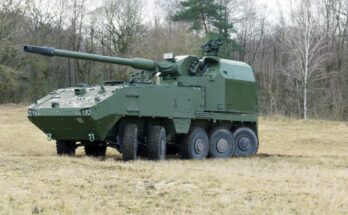by J. Kasper Oestergaard, European Correspondent, Forecast International.

On June 5, the Danish Social Democratic Party and its supporting faction of social-liberal and left-wing parties won a majority of seats in Parliament, defeating the incumbent Liberal Party-led government that won the last election in 2015. While a major upset to the liberal and conservative faction of Parliament, the result is highly unlikely to change the nation’s defense spending plans outlined in the Danish Defense Agreement 2018-2023. Following the election, the agreement continues to have broad political support and is, in the winning faction of Parliament, backed by both the Social Democrats and the Social-Liberal Party.
NATO is the cornerstone of Danish defense and security policy, and the Danish Defense Agreement 2018-2023 originally called for defense spending to increase from 1.2 percent of GDP in 2018 to 1.3 percent by 2023. However, the 2023 target was raised in early 2019 to a more ambitious 1.5 percent. The figure, however, is still well below NATO’s 2 percent threshold, and Denmark will not be able to meet the target before 2024 (at the NATO Summit in Wales in 2014, members agreed to work toward meeting the 2 percent threshold by 2024). Denmark is one of 13 NATO members that will not meet the Wales Declaration’s targets. It should be mentioned, though, that Denmark ranks fifth highest when defense spending is measured per capita. In 2018, Denmark spent $755 per capita on defense, well ahead of countries like Estonia, Greece, and Latvia that all meet or exceed the 2 percent threshold.
While not meeting the Wales Declaration’s targets, the increase in Danish defense expenditures will fund significant equipment investments, and Denmark expects to meet NATO’s guideline that member states allocate 20 percent of their defense budget to new equipment procurement.
Danish Defense Agreement 2018-2023 highlights:
- By 2024, the Danish armed forces will have established a deployable brigade of approximately 4,000 troops that meet NATO’s force goals for a medium-size brigade.
- A light infantry battalion of 500 troops will be established.
- SM-2 missiles will be acquired to boost the area air defense capability of the three Danish Iver Huitfeldt class guided missile frigates (the latest plans call for a purchase of 50 SM-2 missiles). Furthermore, initial preparatory work for a potential procurement of longer range SM-6 missiles will commence. This will provide Denmark with a more complete frigate capacity that meets NATO’s force goals on maritime area air defense.
- Additional flight crews will be added to Air Force C-130J transport aircraft.
- The armed forces will build an effective anti-submarine capability.
- The Political Agreement of June 9, 2016, concerning the acquisition of 27 F-35 aircraft is endorsed.
- A training initiative to secure that fundamental knowledge of minelaying operations is retained is maintained.
- Denmark reconfirms its pledge made at the NATO Summit in Wales in 2014 to contribute to NATO’s defense against ballistic missiles with a sensor capacity.
- A potential acquisition of long-range precision-guided missiles will be investigated.
- Special Operations will be strengthened through a number of new initiatives.
- The Home Guard’s ability to mobilize will be strengthened.
- Substantial funds will be allocated to strengthen Danish cyber defense.
- The armed forces’ abilities to support national police forces will be strengthened.

 Joakim Kasper Oestergaard is Forecast International’s AeroWeb and PowerWeb Webmaster and European Editor. In 2008, he came up with the idea for what would eventually evolve into AeroWeb. Mr. Oestergaard is an expert in aerospace & defense market intelligence, fuel efficiency in civil aviation, defense spending and defense programs. He has an affiliation with Terma Aerostructures A/S in Denmark – a leading manufacturer of composite and metal aerostructures for the F-35 Lightning II. Mr. Oestergaard has a Master’s Degree in Finance and International Business from the Aarhus School of Business – Aarhus University in Denmark.
Joakim Kasper Oestergaard is Forecast International’s AeroWeb and PowerWeb Webmaster and European Editor. In 2008, he came up with the idea for what would eventually evolve into AeroWeb. Mr. Oestergaard is an expert in aerospace & defense market intelligence, fuel efficiency in civil aviation, defense spending and defense programs. He has an affiliation with Terma Aerostructures A/S in Denmark – a leading manufacturer of composite and metal aerostructures for the F-35 Lightning II. Mr. Oestergaard has a Master’s Degree in Finance and International Business from the Aarhus School of Business – Aarhus University in Denmark.
References:
- https://fmn.dk/eng/news/Pages/New-agreement-for-Danish-Defence-2018-2023.aspx
- https://www.fmn.dk/nyheder/Pages/Forsvarsforligskredsen-forstaerker-forsvaret-Danmark-skal-op-paa-15-af-BNP-i-2023.aspx
- https://www.fmn.dk/temaer/forsvarsforlig/Documents/danish-defence-agreement-2018-2023-SUPPLEMENTAL.pdf
- https://www.politico.eu/article/denmarks-social-democrats-on-course-to-win-election/
- https://www.dr.dk/nyheder/udland/40-procent-af-danskerne-vil-haeve-forsvarsbudgettet
- https://www.fmn.dk/videnom/Pages/ministeromraadetsoekonomi.aspx
- https://www.nato.int/nato_static_fl2014/assets/pdf/pdf_2019_03/190314-pr2018-34-eng.pdf
For 50 years, Forecast International intelligence reports have been the aerospace and defense industry standard for accurate research, analysis, and projections. Our experienced analysts compile, evaluate, and present accurate data for decision makers. FI's market research reports offer concise analysis of individual programs and identify market opportunities. Each report includes a program overview, detailed statistics, recent developments and a competitive analysis, culminating in production forecasts spanning 10 or 15 years. Let our market intelligence reports be a key part of reducing uncertainties and mastering your specific market and its growth potential. Find out more at www.forecastinternational.com




